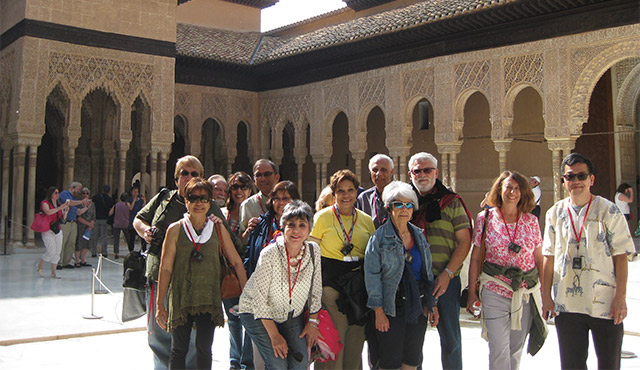In the pre-dawn last month a priest and a band of 12 parishioners, including myself, from St. Timothy Catholic Church in Laguna Niguel boarded a bus to LAX and then a long flight. The destination was Spain and then beyond to Lourdes.
We were a bit nervous about the hectic schedule that afforded little sleep but gave us the opportunity to see a large swath of the country most responsible for exporting Catholicism to the new world. In nine days–besides two spent in airports and on flights–we would travel by bus 1,600 miles, starting in Madrid and stopping in Seville, Cordoba, Granada, Valencia, Montserrat, Barcelona and Lourdes.
At a pre-trip dinner, Father Loc Tran, who had organized the excursion, said this would not be a traditional pilgrimage limited to Catholic shrines. The itinerary also was planned to highlight the important contributions Muslims made to European civilization after the Moors migrated from Africa to southern Spain in 711. Fr. Loc observed that 8th century Spain was remarkable because it was a time when Jews, Muslims and Christians coexisted in relative peace.
We saw Seville’s Alcazar Palace, originally built in the 10th century for governors of the local Muslim state and later expanded under Christian King Petro I, so it reflects Muslim and Christian traditions. In Granada, we walked through the ornate arches, columns, water features and gardens of the Alhambra, the royal palace that was the last Moorish stronghold in Europe. Our guide told us that although the beautiful symmetry seemed perfect, Muslim builders always allowed a slight flaw in deference to God who alone can make perfect things.
Spain’s history is of course also steeped in Christianity, with Christians frequently countermanding Muslim mosques and converting them for Christian worship after Muslims were ultimately pushed out of Spain in 1492.
Several on the trip said they were very moved to see crowds reverently visiting historic Christian sites. At the basilica in Montserrat, high in an awe-inspiring range of stony peaks, we stood in line to kiss the orb of the earth held by the small wooden Black Madonna and listened to the renowned boys choir from the nearby Benedictine abbey.
With a priest to say private Masses for us at historic churches along the way, the tourist sites became personal. After a Mass in a chapel behind the Black Madonna, the couples on the trip repeated their marriage vows. The occasion provided a special memory for Rafael and Julita Lugo who that day marked their 42nd anniversary.
“I would say it was the best anniversary ever. That’s never going to happen again,” Julita said.
Jim Wayda, a convert to Catholicism, said he appreciated having people with whom to pray in sacred places. When he has gone on secular tours, he said, “maybe three or four people would be praying out of a group of 30.”
The common denominator on this trip was Fr. Loc, whom everyone knew through St. Timothy’s Church. He had been reassigned to another church the previous year, so for him the tour was a reunion with friends he had invited. But most of us were strangers to one another at the start of the trip, giving us an opportunity to make new friendships we could continue when we returned home.
“I have seen all of you at church, but I didn’t know your names,” said Sharon Suffecool, another tour member at our introductory meeting.
Not all went smoothly. Calls had to be made so the group could enter the magnificent Basilica de la Sagrada Familia under construction in Barcelona after we learned that the pre-arranged tour stopped outside the church doors.
We had Mass in the church’s crypt beside the tomb of Antonius Gaudi Cornet, the architect who devoted the last 43 years of his life to the multi-spired church that is his masterpiece. We prayed for the construction workers to meet their goal of completing the soaring structure by 2026, the 100th anniversary Gaudi’s death.
During the tour, Fr. Loc frequently broke into song. In Granada he sang in Vietnamese a tribute to a mother’s love in honor of May as Mary’s month. In a more jocular context, when anyone worried aloud about a time crunch, he would belt out a verse or two of Que Sera, Sera, producing smiles.
The last leg of the trip wound through the Pyrenees Mountains to Lourdes in France. The visit to Lourdes was anticipated from the first day of our journey with daily novena prayers said on the bus to Our Lady of Lourdes.
Once in Lourdes, we saw the small room where Bernadette’s family, including two brothers and a sister, lived during the time the Blessed Mother appeared to Bernadette and introduced herself as the Immaculate Conception. We saw the grotto where the visions occurred and took baths in the cold water said to have produced miraculous cures for those of faith.
We were joined by people from many nations, including a large contingent of young men and women belonging to military organizations throughout Europe, who were on a Lourdes pilgrimage. A multinational throng lit candles as evening fell and prayed the Hail Mary in a sequence of languages while walking in procession behind the flags of their origin.
“There were many highlights (to the trip) but the best was Lourdes. It seemed so spiritual with the grotto and the procession and the Masses,” said Douglas Asuncion, who was accompanied by his wife Milagros, a cancer survivor. “That was the reason we took the tour, for Lourdes, and it did not disappoint.”

